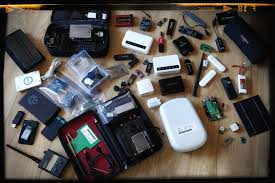In 2024, the landscape of cybersecurity is marked by rapid technological advancements, with hacker gadgets becoming more sophisticated and accessible than ever before. These tools, which once required specialized knowledge and resources, are now within reach of both novice and expert hackers, as well as cybersecurity professionals. The evolution of these gadgets is reshaping how attacks are carried out and defended against, leading to a constant battle between innovation and security.

One of the most significant developments in 2024 is the rise of portable penetration testing kits. These kits are compact, versatile, and incredibly powerful, allowing users to conduct network analysis, exploit vulnerabilities, and perform social engineering attacks with ease. They are equipped with tools like Wi-Fi Pineapples, which can intercept and manipulate wireless network traffic, and USB Rubber Duckies, which can inject malicious keystrokes into computers. The portability and efficiency of these kits have made them a staple in both offensive and defensive cybersecurity operations.
Artificial intelligence has also made a profound impact on the world of hacking. AI-powered phishing tools have become a key weapon in the hacker’s arsenal. These tools use advanced algorithms to analyze a target’s online behavior and craft highly personalized phishing emails that are difficult to distinguish from legitimate communications. This level of personalization increases the likelihood of a successful attack, making phishing more dangerous than ever before.
Bluetooth and NFC hacking gadgets have seen significant advancements as well. These devices can intercept and manipulate communications between Bluetooth or NFC-enabled devices, allowing hackers to eavesdrop on conversations, capture data, and even inject malicious code. The increasing prevalence of wireless technology in everyday life has made these gadgets particularly relevant, as they can be used to exploit vulnerabilities in everything from smartphones to smart home systems.
Wi-Fi deauthentication devices have also become more popular in 2024. These gadgets disrupt Wi-Fi networks by forcing devices to disconnect, which allows hackers to intercept data or create fake access points. They are easy to use and highly effective, making them a go-to tool for network attacks.
Hidden cameras and microphones have become more sophisticated and harder to detect. These espionage tools can be concealed in everyday objects like USB chargers, smoke detectors, and picture frames, capturing audio and video without raising suspicion. They are widely used in corporate espionage, surveillance, and data theft, and their increasing miniaturization has made them more effective than ever.
The Raspberry Pi, a versatile mini-computer, continues to be a favorite among hackers. Exploitation kits built around the Raspberry Pi can be customized to perform a wide range of attacks, from network sniffing to creating rogue access points. Its small size and affordability make it ideal for covert operations and penetration testing.
Drones equipped with hacking tools are another significant development in 2024. These aerial platforms can carry Wi-Fi sniffers, cameras, and even jamming devices, allowing hackers to breach networks from the sky. They offer a new level of mobility and access, making it easier to bypass physical security measures and target otherwise hard-to-reach locations.
USB attack devices remain a potent threat due to their ubiquity and ease of use. The USB Rubber Ducky, for example, can execute pre-programmed keystrokes to compromise a computer, while other devices like the Bash Bunny can perform a variety of attacks, from data exfiltration to privilege escalation. These devices continue to be a major security concern, especially as they become more sophisticated.
RFID skimmers and cloners have also advanced, making it easier to capture and duplicate RFID signals used in access control and contactless payments. These gadgets are often concealed in wallets or mobile phones, allowing hackers to steal information by simply being in close proximity to the target.
Network tap devices have become more compact and harder to detect, providing a passive means to intercept and monitor network traffic. These devices are essential for both offensive and defensive cybersecurity operations, allowing users to gather data, analyze traffic, and identify vulnerabilities without detection.
Hacker gadgets progresses, the line between hacker and defender continues to blur. The same tools used to protect systems are often repurposed for attacks, creating a constantly shifting landscape where innovation and vigilance are key. The future of cybersecurity will undoubtedly be shaped by the ongoing evolution of these hacker gadgets, as both sides strive to stay one step ahead